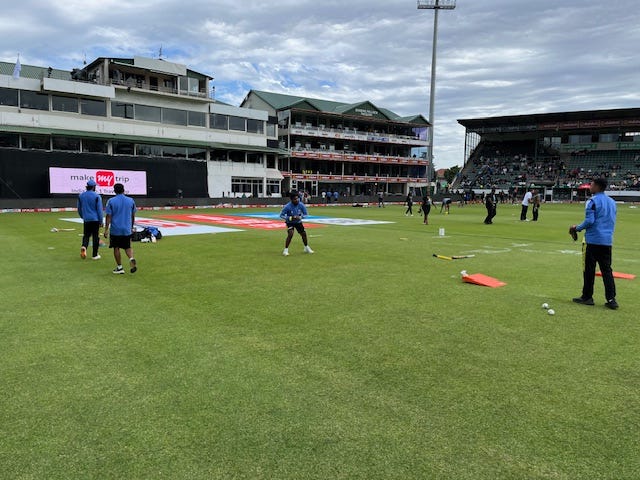It was Cricket Australia, as I recall, that set the international game off on its current dizzying path, but it could just as easily have been India or England. The details aren’t important. Readers will no doubt inform me, and I will gratefully receive their research.
It is with some amusement now that I recall the shock of CA agreeing to a schedule which saw back-to-back matches, in different formats, and had David Warner arriving in a different country the day before a Test match having just played a white ball international. Otherwise, the squads were entirely different.
The humour lies in just how quickly this has become entirely normal. It was a seminal moment in the game and attracted widespread outrage. I was amongst many who condemned the scheduling as an act born of arrogance and disrespect. The more I chuckle.
These days, overlapping international fixtures are commonplace and entirely different, co-existent national squads barely raise an eyebrow. Just this week England are playing the West Indies in a T20 series in the Caribbean while another England land in New Zealand to prepare for their three-Test series.
New Zealand, meanwhile, celebrated their greatest ever Test series, a 3-0 clean sweep against India, by flying home to prepare for another three Tests against England and leaving another New Zealand team behind on the subcontinent to play a T20 series against Sri Lanka. Mitchell Santner and Will Young are amongst the rare cross-overs.
“Yes, we know you were the player-of-the-series, Will, but obviously Kane has to come back and, you know, we’ll keep some champagne for you. Anyway, Mitch took 13 in the series winning Test so you’re not alone. Anyway, they’re only T20s…”
Many observers believed that Cricket Australia’s unprecedented decision would set a new level for financial greed which would eventually see the game choke on its own excess. Looking back, the degree of moral outrage seems hilarious now. We had no concept of how vast and chaotic the scramble for fixtures and revenue would become.
Warnings about ‘tipping points’ have abounded for years but there is, in fact, little evidence to suggest that the game is going to ‘break’. People can die of consumption but, apparently, a sport cannot. At least, cricket cannot.
The international product can be watered down to the point of tastelessness and there are still sufficient consumers to make it financially viable. Doomsayers warned about the dangers of saturation and ‘meaningless’ cricket years ago but evidently had no idea of how robust the market actually is.
Some international fixtures don’t even require the administrative boards to show them a basic level of respect. In Australia recently the home side rested every single one of their first choice XI in an ODI series decider against Pakistan and were consequently thrashed. It didn’t matter. ODI cricket is the cockroach which cannot be killed.
Evidently the fear that advertisers would eventually suffer from budget fatigue when it came to displaying their wares during matches with minimal viewers, live or electronic, has proven to be unfounded. Even involving contests without the Indian team and its gargantuan, guaranteed following.
The appetite for a non-stop, overlapping and confusing schedule has obviously been underestimated. Followers of American sports, like baseball, point to the fact that MLB teams play 162 regular games per year. That is an awful lot of pitching and hitting, far more activity than is required from today’s cricketers.
Several aspects of cricket may have been missing from the pessimists’ calculations. The first is the organic grading process which allows followers to identify the big matches and still accept the small ones, separating the important from the trivial. Whereas the ‘less is more’ strategy works well in theory, maximising revenue for iconic series and contests, it does not, it seems, preclude or even lessen interest, even in the most forgettable fixtures.
Advertisers and sponsors like to drive a hard bargain and make broadcasters believe they are on the brink of walking away. But the truth is, no mainstream sport outside of America can match the exposure offered by international white ball cricket. It isn’t just the four or eight hours it takes to show the games live, it’s the hundreds of hours of repeats for decades to come. There are dozens of channels in Asia which air almost nothing but old cricket internationals.
Of course, there are still some experts who believe the current orgy of international cricket is unmanageable and unsustainable and that, eventually, bilateral series for an obscure sponsor’s trophy will not attract enough attention or revenue to be viable, even as a bundled-in loss-leader for more meaningful cricket. And they are surely correct…aren’t they?
But until that time eventually comes there is something curiously entertaining about watching the train continue to gather speed until the brakes fail and it is derailed. The healthiest survivors will be those closest to India and the BCCI. For all its dysfunction in recent years, CSA has positioned itself well in that regard, for now.
The ongoing T20 series, levelled by the Proteas at 1-1 after a deliciously low-scoring thriller at St.George’s Park in Gqeberha on Sunday, is providing valuable experience for a number of new faces. And a game-changing $8.5 million for each of the four matches. Game on.







Your comment about baseball is well- placed. Teams often play matches on consecutive days too. I'm not interested in watching all these bilateral series' that don't involve our Proteas, but clearly millions are. This '2nd string' Indian team here is still very good & entertaining to watch.
...there is something curiously entertaining about watching the train continue to gather speed until the brakes fail and it is derailed...
I had a good chuckle. Well written, as always. Thank you.